The best barbell exercises for optimal muscle building
Share
The best barbell exercises for optimal muscle building
Ancient hunters and gladiators already used barbells and weights to train their bodies. Barbell training was even an official Olympic sport!
Nowadays, barbell training is primarily used to build muscle and strength. The key difference from training on machines: with dumbbells, you can isolate your muscles, but most exercises with these freely movable weights also utilize many accessory muscles. This is the only way to keep your body, especially your torso, stable. And that's precisely what makes barbell exercises so effective.
If you want to build muscle specifically, strength training is essential. In this blog post, we'll show you effective barbell exercises to get your body in top shape! Read on, and you're guaranteed to find the best dumbbell and barbell exercises to achieve your goals.
What types of barbells are there?
A broad distinction is made between dumbbells and barbells. Both allow for an effective full-body workout at home. Some prefer dumbbells, others barbells . A combination of the two is certainly ideal. Dumbbells offer the advantage of isolating muscle training. The movements are more natural and better adapted to our anatomy. They also help improve coordination. However, be sure to choose the right weight and maintain correct posture.
Generally, training with free weights requires a bit more practice. Even the smallest changes in weight or balance activate different muscles. If you're working without a trainer, ideally, train in front of a mirror or with a partner to check each other's posture and correct it if necessary.
How Do Dumbbell Exercises Make My Muscles Grow?
Muscles always grow when you work them intensively. Properly performed barbell training with the right weights leads to micro-tears at the cellular level. The body repairs this damage, and the muscles regenerate and gain strength and mass. The more you train, the bigger the individual muscles become.
Very important: muscles grow during the recovery phase. The training itself only stimulates them to do so. Beginners should give the trained muscle groups 48 hours to regenerate. Advanced and professional athletes can shorten this time to 36 or even 24 hours.
What should I pay attention to when doing a barbell workout at home?
It looks so easy, but barbell exercises are more challenging than most people think. This is especially true with dumbbells. You move the weights freely, so you don't have the support you do with equipment. This has the advantage of also working the deep muscles that are so important for posture and stability.
The weight is very important in such exercises, so that the training can be as coordinated as possible:
• Beginners start with dumbbells weighing 2-4 kg, depending on the exercise.
• Advanced users choose dumbbells of 5-8 kg.
• With barbells, beginners start with 10 to 20 kilos, depending on the exercise.
• Advanced users can choose significantly higher weights depending on the exercise.
• You should repeat each exercise 12-15 times.
• For advanced and professionals working with high and very high weights, 6 to 8 repetitions.
• 3 sets per exercise with 60 seconds rest in between is ideal.
• The optimal barbell training consists of multi-joint and single-joint exercises.
• Rule of thumb: The correct weight is chosen if you cannot perform the last repetition properly.
The training program: how do you build a good barbell workout?
For effective barbell training at home, you need to observe some basic rules:
• Every time you train, first do complex exercises and then do isolated exercises.
• Train the flexors first, then the extensors.
• Train the extremities first, then the core muscles.
• Warm up for a few minutes before each workout.
• Beginners train 2 or 3 times a week for the first 6 to 8 weeks.
Advanced users can increase to 4 or even 5 units, but should not train the same muscle groups on consecutive days.
The best barbell exercises for beginners
Want to get started too? We'll give you some exercises that are perfect to get you started. Check out this blog post too!
Dumbbell exercises
As a beginner, six exercises with three sets of 12 to 15 repetitions per set are sufficient. If you train regularly two to three times a week, you'll build a decent base in six to eight weeks and can move on to more complex exercises.
Lunges with dumbbells
Trains the thigh and gluteal muscles
Take a dumbbell in each hand and hold them next to your body with your arms extended. With a straight back, bend your knees to a 90-degree angle, hold the low position briefly, and then stand back up without fully extending your legs.
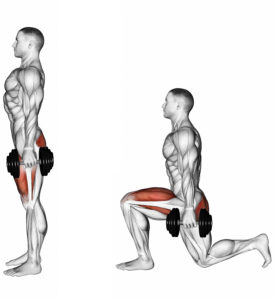
Bench press with dumbbells
Trains the chest muscles and triceps
Lie on a weight bench. Hold a dumbbell in each hand. Lift them vertically over your collarbone until your arms are almost fully extended. Then slowly lower your arms with the weights until they are in line with your chest. Then push the weights back up in an arc.
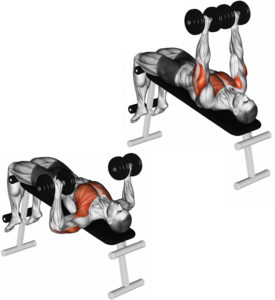
Bent-over rowing with dumbbells
Trains the large back muscles, glutes and hamstrings
Take a dumbbell in your right and left hands. Then bend your knees and simultaneously lean your torso forward, keeping it completely straight. From this position, pull the dumbbells up until they just touch your torso. Hold briefly, then lower them.
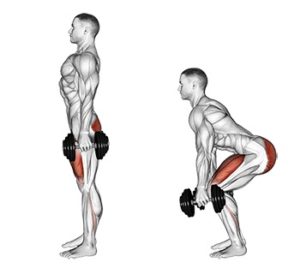
Shoulder press with dumbbells
Trains the anterior deltoid and triceps
Sit on a stool or bench. Take a dumbbell in your right and left hands and hold them at shoulder height with your arms bent. The tips of the dumbbells should point forward. Then extend your arms upward and rotate the dumbbells so your fingers are visible from the front. Hold briefly and lower them in a controlled manner.
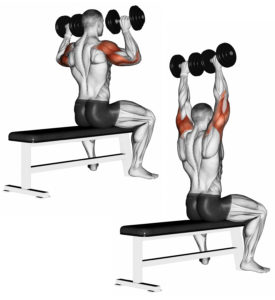
Bicep curls with dumbbells
Trains the biceps and upper arm muscles
Sit on a bench or stool. Hold a dumbbell in your right hand and rest the outer side of your upper arm against your inner thigh. Then bend your arm with the weight. Keep your elbow steady, and keep the outer side of your upper arm in contact with your inner thigh. Hold briefly and stretch again. After three sets, train the other arm.
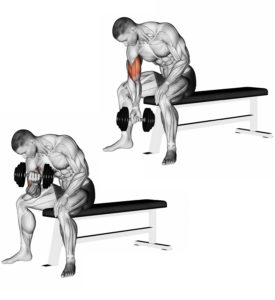
Triceps extensions with dumbbells
Exercises the triceps and elbow muscles
Pick up a dumbbell and stand upright with your knees slightly bent. Raise your arm holding the weight directly above your head. Place your free arm across your torso. Then lower the dumbbell behind your head. Pause briefly at the end of the movement and then straighten your arm again. After three sets, switch to the other hand.
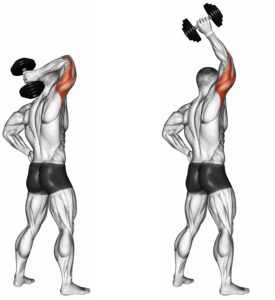
Barbell training for beginners
Here are four exercises beginners can do with barbells. Because it's important to learn the correct sequence of movements first, working with the barbell without any additional weights is often sufficient. After three sets, you can also add a few weights.
Squat with barbell
Trains the glutes, quadriceps and hamstrings
Place the barbell behind your head on your shoulders and grasp it with both hands. Stand hip-width apart, feet slightly outward, allowing your knees to follow your feet. Then squat down to a 90-degree angle with your back completely straight and your abs and glutes engaged. Pause briefly, then return to standing in a controlled manner without fully extending your knees.
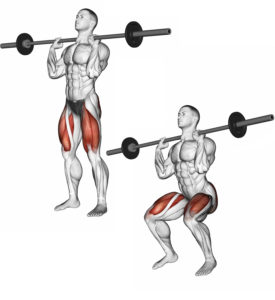
Bench press
Trains the pectoral muscles, triceps and deltoid muscles
Lie on a weight bench . Grip the barbell with a wide grip and then slowly lower it to just below your chest. Hold briefly, then press back up with control. Don't fully extend your arms to maintain muscle tension.
.jpg)
Rowing with barbell
Trains the large back muscles, biceps and glutes
The barbell lies on the floor in front of your feet. Then, bend your knees with a straight back, grab the barbell with a wide grip, and lift it until it's level with your shins. From this position, pull the bar up until it touches your body. Hold briefly, then lower it again.
.jpg)
Triceps extensions with a barbell
Trains the triceps and elbow muscles
Sit upright on a bench or stool and grip the barbell shoulder-width apart. Then raise your arms straight above your head, keeping your core engaged. Slowly lower the barbell behind your head toward your back until your forearms touch your biceps. Pause briefly, then straighten your forearms again.
.jpg)